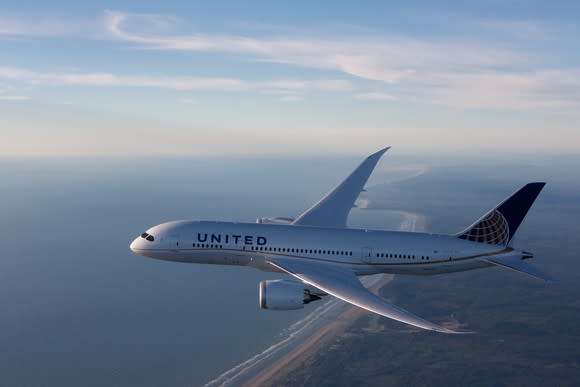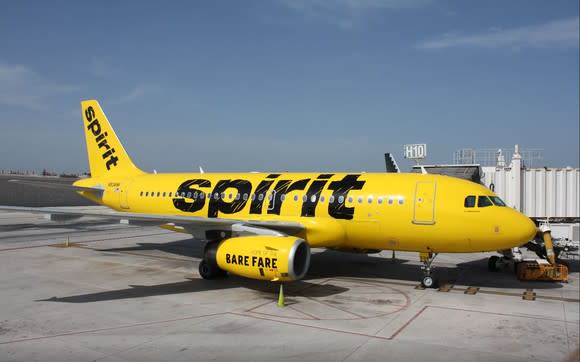United Continental Raises Guidance Again: Can It Keep Up the Momentum?
Back in October, shares of United Continental (NYSE: UAL) plunged after the company posted weak third-quarter earnings and released a downbeat outlook for the fourth quarter. Unit revenue declines highlighted the cost of an ongoing fare war with ultra-low-cost carriers such as Spirit Airlines (NYSE: SAVE) and Frontier Airlines. Additionally, management appeared to back away from United's earlier forecast that non-fuel unit costs would rise no more than 1% in 2018.
Since then, United has raised its Q4 guidance twice. On Tuesday, the company indicated that unit revenue and unit costs both came in better than expected last quarter. This is a promising sign -- but investors should wait to see if performance continues to improve before considering an investment in United Continental.
United Continental updates its fourth-quarter forecast
United's initial Q4 forecast called for passenger revenue per available seat mile (PRASM) to decline 1% to 3% year over year, with most of the decline coming in December. Meanwhile, the company projected that adjusted non-fuel unit costs would rise by 2.5% to 3.5%. The net result was that it expected to produce a slim adjusted pre-tax margin of 3% to 5%.
However, United Continental raised its revenue guidance by 1 percentage point last month, hinting at an improving revenue environment.

United Continental's Q4 unit revenue outlook has improved significantly. Image source: United Airlines.
The company's final guidance update, issued this week, provided even better news. PRASM will come in roughly flat on a year-over-year basis, reaching the high end of the updated forecast range. Additionally, management estimates that adjusted non-fuel unit costs rose just 1.5% to 2% year over year, well below the original forecast.
United Continental attributed the stronger-than-expected fourth-quarter revenue performance to an uptick in close-in demand. Better reliability, lower benefits-related expenses, and the timing of certain costs contributed to holding down non-fuel unit cost growth.
Better margin performance -- but nothing to write home about
The combination of stronger unit revenue and lower non-fuel cost growth more than offset the impact of an increase in fuel prices during the fourth quarter. As a result, United Continental now expects to post a pre-tax margin of 6% to 7% for the quarter, even though it paid an average of $1.91 per gallon for jet fuel -- well above its original estimate of $1.80 to $1.85.
Still, that's not exactly cause for celebration. United's Q4 2016 adjusted pre-tax margin was significantly higher, at 9.5%. (It was even higher the year before.) United Continental may have slowed its rate of margin deterioration, but it still hasn't stabilized its profitability.
Will United gain momentum this year?
It will be extremely important for United Continental to accelerate its unit revenue growth in the year ahead. Jet fuel prices have been flying higher since late October. Thus, while United paid $1.91 per gallon last quarter, it could face an average jet fuel price of more than $2.10 per gallon in 2018 if fuel prices remain near current levels.
This alone would be a roughly 4-percentage-point headwind to United's pre-tax margin. Assuming that non-fuel unit costs rise 1% to 2%, United could need PRASM growth of about 5% just to match its subpar 2017 pre-tax margin (which will be approximately 8.5%).
Most investors would probably be happy if United were able to merely hold pre-tax profit steady in the face of higher fuel costs. The benefits of tax reform would then flow through to the bottom line. However, achieving a 5% full-year PRASM increase would be no easy feat.
The longer-term outlook is uncertain
At some point, the price of jet fuel will stop rising, giving airlines an opportunity to bolster their margins via continued unit revenue growth. That said, United (and its legacy carrier peers) will face a significant threat from the ongoing growth of Spirit Airlines, Frontier Airlines, and other low-fare airlines.

Spirit Airlines and other smaller carriers are growing quickly. Image source: Spirit Airlines.
Frontier Airlines recently ordered 134 new aircraft as part of a plan to roughly triple in size over the next decade. Spirit Airlines plans to expand 22% to 25% in 2018, before slowing its annual growth rate to between 10% and 15% thereafter. However, a provision of the recent tax reform bill that incentivizes capital spending could encourage Spirit (and other airlines in a similar position) to grow faster, undermining the industry's unit revenue growth.
United faces threats in the international arena as well. The rapid growth of Chinese carriers has depressed fares in the U.S.-China market for years. Singapore Airlines is expected to restart nonstop flights from Singapore to New York and Los Angeles this year, using a new long-range version of the A350-900. Finally, European budget airlines continue to add routes between the U.S. and major European tourist markets at a rapid pace.
United Continental stock is relatively cheap, trading for about 10 times the company's 2017 EPS. The company also has a big tax-reform EPS boost coming, while management has touted a long-term plan to add billions of dollars to the bottom line. Nevertheless, until United proves that it can successfully navigate the numerous potential pitfalls it faces, investors should stay away.
More From The Motley Fool
Adam Levine-Weinberg owns shares of Spirit Airlines. The Motley Fool owns shares of and recommends Spirit Airlines. The Motley Fool has a disclosure policy.
